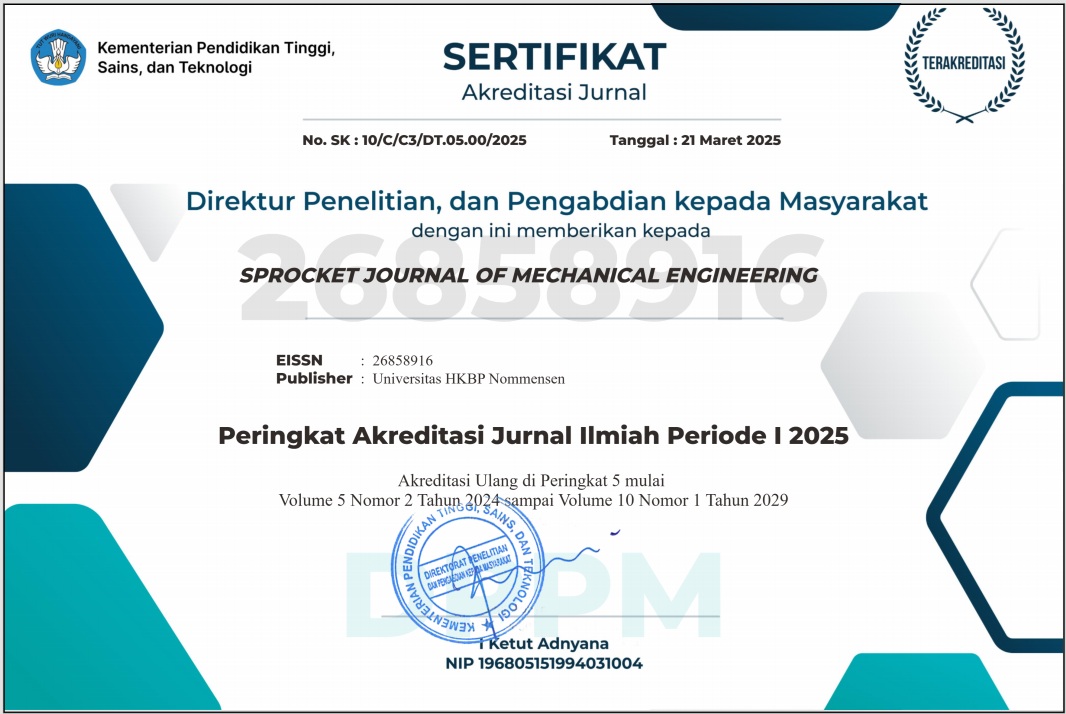Pembuatan Dan Pengujian Alat Ukur Intensitas Cahaya Lepas Pantai Menggunakan Sensor BH-1750
Abstract
Utilization of solar energy sources is an alternative energy to save fossil energy. The use of solar panels has been widely implemented both at home, buildings and open fields. The most sources of sunlight are on the beach, because the beach area has an area without exposure to sunlight. Against this background, this study aims to create an instrument for measuring light intensity offshore. The method used is by reviewing literature studies, making light intensity measuring instruments, testing on the beach and analyzing data. The results obtained during the initial test were that the highest light intensity was in minute 10 of 50578 lx with the highest power of 399.5662 W/m2 at 360C. In testing at 09.00-09.30 WIT with a temperature of 460C produced the highest light intensity was in the 15th minute of 56145 lx with the highest power of 443.5455 W/m2. In testing at 10.00-10.30 WIB with a temperature of 490C, the highest light intensity was at 30 minutes of 57853 lx with the highest power of 457.0387 W/m2. And testing at 11.00-11.30 WIB with a temperature of 500C produced the highest light intensity at 75 minutes of 62845 lx with the highest power of 496.4755 W/m2. The conclusion of this study is that a microcontroller-based light intensity measuring instrument can be developed and used in offshore light intensity measurements.
Keyword: Light Intensity, Microkontroller, Sensor BH-1750.
References
[2] Amanda Khaira Perdana, & Hasyim Rosma, I. (2017). Analisis Kalibrasi Sensor BH1750 Untuk Mengukur Radiasi Matahari Di Pekanbaru. SeMNASTeK 2017, 1–6.
[3] Dodi Mulyadi, Fathan Mubina Dewadi, Amir, Murtalim, & Khoirudin. (2021). Analisis Rancangan Sel Surya Untuk Kebutuhan Cadangan Energi Listrik Di Kolam Wilayah Graha Raya Bintaro, Tangerang Selatan. Jurnal Teknik Mesin Mechanical Xplore, 2(1), 6–12. https://doi.org/10.36805/jtmmx.v2i1.1931
[4] Gerak, M., Mengertahui, D. A. N., Solar, O., & Panel, T. (2021). Pemanfaatan sensor bh 1750 terhadap intensitas cahaya matahari untuk mengatur gerak dan mengertahui optimasi solar tracking panel. 1(1), 96–100.
[5] Kasrani, M. W., B, A. A., & Putra, A. S. (2020). Perancangan Sistem Pengendalian Kecerahan Lampu Utama Pada Mobil Berbasis Arduino Uno. Jurnal Teknik Elektro Uniba (JTE UNIBA), 5(1), 104–108. https://doi.org/10.36277/jteuniba.v5i1.88
[6] PAMUNGKAS, M., HAFIDDUDIN, H., & ROHMAH, Y. S. (2015). Perancangan dan Realisasi Alat Pengukur Intensitas Cahaya. ELKOMIKA: Jurnal Teknik Energi Elektrik, Teknik Telekomunikasi, & Teknik Elektronika, 3(2), 120. https://doi.org/10.26760/elkomika.v3i2.120
[7] Kadir, Abdul. 2013. Panduan Praktis Mempelajari Aplikasi Mikrokontroler dan Pemrogramannya Menggunakan Arduino. Yogyakarta: Penerbit ANDI.
[8] B. Gustomo. 2015. Pengenalan Arduino dan Pemrogrammannya. Bandung: Informatika Bandung.
[9] Light Sensor. 2014. http://indoware.com/produk2855-light-sensor-bh1750- bh1750fvi.html. Diakses tanggal 30 Desember 2022
[10] Agus Faudin, Cara mengakses modul display LCD 16x2, 2018. Website: https://www.nyebarilmu.com/cara-mengakses-modul-display-lcd-16x2/#:~:text=LCD%2016%C3%972%20(Liquid,televisi%2C%20atau%20pun%20layar%20komputer, diakses tanggal 06 Januari 2023
[11] Hariyanto, Didik. 2010. Analog To Digital Converter. http://staff.uny.ac.id/sites/default/files/Teknik%20Antarmuka%20-20%ADC.pdf. Diunduh 06 Januari 2023

This work is licensed under a Creative Commons Attribution 4.0 International License.
Penulis yang menerbitkan dengan SPROCKET JOURNAL OF MECHANICAL ENGINEERING menyetujui ketentuan berikut :
- Penulis memegang hak cipta dan memberikan jurnal hak penerbitan pertama dengan karya yang dilisensikan secara bersamaan di bawah Lisensi Internasional Creative Commons Atribusi 4.0 . yang memungkinkan orang lain untuk berbagi karya tersebut dengan pengakuan atas kepengarangan karya dan penerbitan awal dalam jurnal ini.
- Penulis dapat membuat pengaturan kontraktual tambahan yang terpisah untuk distribusi non-eksklusif atas versi jurnal yang diterbitkan dari suatu karya (misalnya, mempostingnya ke repositori institusional atau menerbitkannya dalam sebuah buku), dengan pengakuan atas penerbitan awalnya di jurnal ini.
- Penulis diizinkan dan didorong untuk mengunggah karya mereka secara daring (misalnya, di repositori institusi atau di situs web mereka) sebelum dan selama proses penyerahan, karena hal ini dapat mengarah pada pertukaran yang produktif, serta kutipan yang lebih awal dan lebih banyak dari karya yang diterbitkan (Lihat Pengaruh Akses Terbuka ).






.png)
.png)

